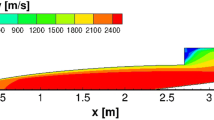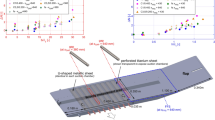Abstract
It is well known that hypersonic boundary-layer transition is sensitive to a surface roughness since the roughness may either trigger an early transition or delay the transition. Hypersonic transition is still poorly understood as there are a very limited number of studies in the literature. In the present work, we conduct a computational study on the transition process of a hypersonic Mach 6 flow over a flat plate with a gap. An implicit large eddy simulation approach based on the flux reconstruction/correction procedure via a reconstruction method is used to investigate the interaction between the hypersonic boundary layer and a gap. Flow structures with and without the gap are compared to analyze the local skin friction coefficient overshoots before and after the gap. Two inlet angles of attack are investigated. The evolution of the skin friction coefficient shows that the gap has a very limited influence on the oblique transition at a zero angle of attack. In contrast, the gap can trigger an early transition at a negative angle of attack. In this case, the transverse feedback mechanism is believed to be the main cause, which amplifies the broadband instability waves.
















Similar content being viewed by others
References
Kimmel, R.: Roughness considerations for HIFiRE-1 vehicle. 38th Fluid Dynamics Conference and Exhibit, Seattle, WA, AIAA Paper 2008–4293 (2008). https://doi.org/10.2514/6.2008-4293
Kimmel, R.L., Adamczak, D.W., Borg, M.P., Jewell, J.S., Juliano, T.J., Stanfield, S., Berger, K.T.: HIFiRE-1 and -5 flight and ground tests. 2018 AIAA Aerospace Sciences Meeting, Kissimmee, FL, AIAA Paper 2018-0056 (2018). https://doi.org/10.2514/6.2018-0056
Rossiter, J.E.: Wind tunnel experiments on the flow over rectangular cavities at subsonic and transonic speeds. Technical Report, Ministry of Aviation; Royal Aircraft Establishment; RAE Farnborough (1964)
Heller, H.H., Bliss, D.B.: Flow-induced pressure fluctuations in cavities and concepts for their suppression. Aeroacoust. STOL Noise Airframe Airfoil Noise, AIAA Progress in Astronautics and Aeronautics, Vol. 45, 281–296 (1976). https://doi.org/10.2514/4.865190
Zhang, X., Edwards, J.: An investigation of supersonic oscillatory cavity flows driven by thick shear layers. Aeronaut. J. 94(940), 355–364 (1990). https://doi.org/10.1017/S0001924000023319
Tam, C.J., Orkwis, P.D., Disimile, P.J.: Algebraic turbulence model simulations of supersonic open-cavity flow physics. AIAA J. 34(11), 2255–2260 (1996). https://doi.org/10.2514/3.13388
Li, W., Nonomura, T., Oyama, A., Fujii, K.: LES study of feedback-loop mechanism of supersonic open cavity flows. 40th Fluid Dynamics Conference and Exhibit, Chicago, IL, AIAA Paper 2010–5112 (2010). https://doi.org/10.2514/6.2010-5112
Wang, H., Sun, M., Qin, N., Wu, H., Wang, Z.: Characteristics of oscillations in supersonic open cavity flows. Flow Turbul. Combust. 90(1), 121–142 (2013). https://doi.org/10.1007/s10494-012-9434-8
Mack, L.M.: Boundary-layer linear stability theory. Technical Report, California Inst of Tech Pasadena Jet Propulsion Lab (1984)
Marxen, O., Iaccarino, G., Shaqfeh, E.S.: Disturbance evolution in a Mach 4.8 boundary layer with two-dimensional roughness-induced separation and shock. J. Fluid Mech. 648, 435–469 (2010). https://doi.org/10.1017/S0022112009992758
Marxen, O., Iaccarino, G., Shaqfeh, E.S.: Nonlinear instability of a supersonic boundary layer with two-dimensional roughness. J. Fluid Mech. 752, 497–520 (2014). https://doi.org/10.1017/jfm.2014.266
Duan, L., Wang, X., Zhong, X.: A high-order cut-cell method for numerical simulation of hypersonic boundary-layer instability with surface roughness. J. Comput. Phys. 229(19), 7207–7237 (2010). https://doi.org/10.1016/j.jcp.2010.06.008
Duan, L., Wang, X., Zhong, X.: Stabilization of a Mach 5.92 boundary layer by two-dimensional finite-height roughness. AIAA J. 51(1), 266–270 (2012). https://doi.org/10.2514/1.J051643
Fong, K.D., Wang, X., Zhong, X.: Numerical simulation of roughness effect on the stability of a hypersonic boundary layer. Comput. Fluids 96, 350–367 (2014). https://doi.org/10.1016/j.compfluid.2014.01.009
Sawaya, J., Sassanis, V., Yassir, S., Sescu, A., Visbal, M.: Assessment of the impact of two-dimensional wall deformation shape on high-speed boundary-layer disturbances. AIAA J. 56(12), 4787–4800 (2018). https://doi.org/10.2514/1.J057045
Tang, Q., Zhu, Y., Chen, X., Lee, C.: Development of second-mode instability in a Mach 6 flat plate boundary layer with two-dimensional roughness. Phys. Fluids 27(6), 064105 (2015). https://doi.org/10.1063/1.4922389
Franko, K.J., Lele, S.K.: Breakdown mechanisms and heat transfer overshoot in hypersonic zero pressure gradient boundary layers. J. Fluid Mech. 730, 491–532 (2013). https://doi.org/10.1017/jfm.2013.350
Guvernyuk, S., Zubkov, A., Simonenko, M.: Experimental investigation of the supersonic flow over an axisymmetric ring cavity. J. Eng. Phys. Thermophys. 89(3), 678–687 (2016). https://doi.org/10.1007/s10891-016-1426-4
Xiao, L., Xiao, Z., Duan, Z., Fu, S.: Improved-delayed-detached-eddy simulation of cavity-induced transition in hypersonic boundary layer. Int. J. Heat Fluid Flow 51, 138–150 (2015). https://doi.org/10.1016/j.ijheatfluidflow.2014.10.007
Mohri, K., Hillier, R.: Computational and experimental study of supersonic flow over axisymmetric cavities. Shock Waves 21(3), 175–191 (2011). https://doi.org/10.1007/s00193-011-0312-4
Mayer, C.S., Von Terzi, D.A., Fasel, H.F.: Direct numerical simulation of complete transition to turbulence via oblique breakdown at Mach 3. J. Fluid Mech. 674, 5–42 (2011). https://doi.org/10.1017/S0022112010005094
Yu, M., Luo, Js: Nonlinear evolution of Klebanoff type second mode disturbances in supersonic flat-plate boundary layer. Appl. Math. Mech. 35(3), 359–368 (2014). https://doi.org/10.1007/s10483-014-1796-8
Egorov, I., Fedorov, A., Soudakov, V.: Direct numerical simulation of disturbances generated by periodic suction-blowing in a hypersonic boundary layer. Theor. Comput. Fluid Dyn. 20(1), 41–54 (2006). https://doi.org/10.1007/s00162-005-0001-y
Wang, X., Zhong, X., Ma, Y.: Response of a hypersonic boundary layer to wall blowing-suction. AIAA J. 49(7), 1336–1353 (2011). https://doi.org/10.2514/1.J050173
Huynh, H.T.: A flux reconstruction approach to high-order schemes including discontinuous Galerkin methods. 18th AIAA Computational Fluid Dynamics Conference, Miami, FL, AIAA Paper 2007-4079 (2007). https://doi.org/10.2514/6.2007-4079
Wang, Z.J., Gao, H.: A unifying lifting collocation penalty formulation including the discontinuous Galerkin, spectral volume/difference methods for conservation laws on mixed grids. J. Comput. Phys. 228(21), 8161–8186 (2009). https://doi.org/10.1016/j.jcp.2009.07.036
Li, Y., Wang, Z.J.: A convergent and accuracy preserving limiter for the FR/CPR method. 55th AIAA Aerospace Sciences Meeting, Grapevine, TX, AIAA Paper 2017-0756 (2017). https://doi.org/10.2514/6.2017-0756
Wang, Z., Li, Y., Jia, F., Laskowski, G., Kopriva, J., Paliath, U., Bhaskaran, R.: Towards industrial large eddy simulation using the FR/CPR method. Comput. Fluids 156, 579–589 (2017). https://doi.org/10.1016/j.compfluid.2017.04.026
Haga, T., Gao, H., Wang, Z.J.: A high-order unifying discontinuous formulation for the Navier–Stokes equations on 3D mixed grids. Math. Model. Nat. Phenom. 6(3), 28–56 (2011). https://doi.org/10.1051/mmnp/20116302
Wang, Z., Gao, H., Haga, T.: A unifying discontinuous CPR formulation for the Navier–Stokes equations on mixed grids. Computational Fluid Dynamics 2010, pp. 59–65. Springer (2011). https://doi.org/10.1007/978-3-642-17884-9_5
Huynh, H., Wang, Z.J., Vincent, P.E.: High-order methods for computational fluid dynamics: A brief review of compact differential formulations on unstructured grids. Comput. Fluids 98, 209–220 (2014). https://doi.org/10.1016/j.compfluid.2013.12.007
Park, J.S., You, H., Kim, C.: Higher-order multi-dimensional limiting process for DG and FR/CPR methods on tetrahedral meshes. Comput. Fluids 154, 322–334 (2017). https://doi.org/10.1016/j.compfluid.2017.03.006
Vermeire, B.C., Witherden, F.D., Vincent, P.E.: On the utility of GPU accelerated high-order methods for unsteady flow simulations: A comparison with industry-standard tools. J. Comput. Phys. 334, 497–521 (2017). https://doi.org/10.1016/j.jcp.2016.12.049
Wang, Z.: A perspective on high-order methods in computational fluid dynamics. Sci. China Phys. Mech. Astron. 59(1), 614701 (2016). https://doi.org/10.1007/s11433-015-5706-3
Bassi, F., Rebay, S.: A high order discontinuous Galerkin method for compressible turbulent flows. Discontinuous Galerkin Methods, pp. 77–88. Springer (2000). https://doi.org/10.1007/978-3-642-59721-3_4
Sun, Y., Wang, Z., Liu, Y.: Efficient implicit non-linear LU-SGS approach for viscous flow computation using high-order spectral difference method. 18th AIAA Computational Fluid Dynamics Conference, Miami, FL, AIAA Paper 2007-4322 (2007). https://doi.org/10.2514/6.2007-4322
Ren, J., Fu, S.: Competition of the multiple Görtler modes in hypersonic boundary layer flows. Sci. China Phys. Mech. Astron. 57(6), 1178–1193 (2014). https://doi.org/10.1007/s11433-014-5454-9
Shadloo, M., Hadjadj, A.: Laminar–turbulent transition in supersonic boundary layers with surface heat transfer: A numerical study. Numer. Heat Transf. A Appl. 72(1), 40–53 (2017). https://doi.org/10.1080/10407782.2017.1353380
Pirozzoli, S., Grasso, F., Gatski, T.: Direct numerical simulation and analysis of a spatially evolving supersonic turbulent boundary layer at M = 2.25. Phys. Fluids 16(3), 530–545 (2004). https://doi.org/10.1063/1.1637604
Huai, X., Joslin, R.D., Piomelli, U.: Large-eddy simulation of transition to turbulence in boundary layers. Theor. Comput. Fluid Dyn. 9(2), 149–163 (1997). https://doi.org/10.1007/s001620050037
Hunt, J.C., Wray, A.A., Moin, P.: Eddies, streams, and convergence zones in turbulent flows. Studying Turbulence Using Numerical Simulation Databases, 2. Proceedings of the 1988 Summer Program, pp. 193–208 (1988)
Tsuji, Y., Fransson, J.H., Alfredsson, P.H., Johansson, A.V.: Pressure statistics and their scaling in high-Reynolds-number turbulent boundary layers. J. Fluid Mech. 585, 1–40 (2007). https://doi.org/10.1017/S0022112007006076
Zhang, C., Duan, L., Choudhari, M.M.: Effect of wall cooling on boundary-layer-induced pressure fluctuations at Mach 6. J. Fluid Mech. 822, 5–30 (2017). https://doi.org/10.1017/jfm.2017.212
White, F.M., Corfield, I.: Viscous Fluid Flow, vol. 3. McGraw-Hill, New York (2006)
Acknowledgements
The first author acknowledges the support by the Tsinghua Scholarship for Overseas Graduate Studies and thanks the University of Kansas (KU) for hosting her visit to KU. This work is also partly supported by NSFC Grant 11572176.
Author information
Authors and Affiliations
Corresponding author
Additional information
Communicated by C.-H. Chang.
Publisher's Note
Springer Nature remains neutral with regard to jurisdictional claims in published maps and institutional affiliations.
Rights and permissions
About this article
Cite this article
Xue, Y., Wang, L., Wang, Z.J. et al. Gap-induced transition via oblique breakdown at Mach 6. Shock Waves 29, 1181–1190 (2019). https://doi.org/10.1007/s00193-019-00926-y
Received:
Revised:
Accepted:
Published:
Issue Date:
DOI: https://doi.org/10.1007/s00193-019-00926-y




